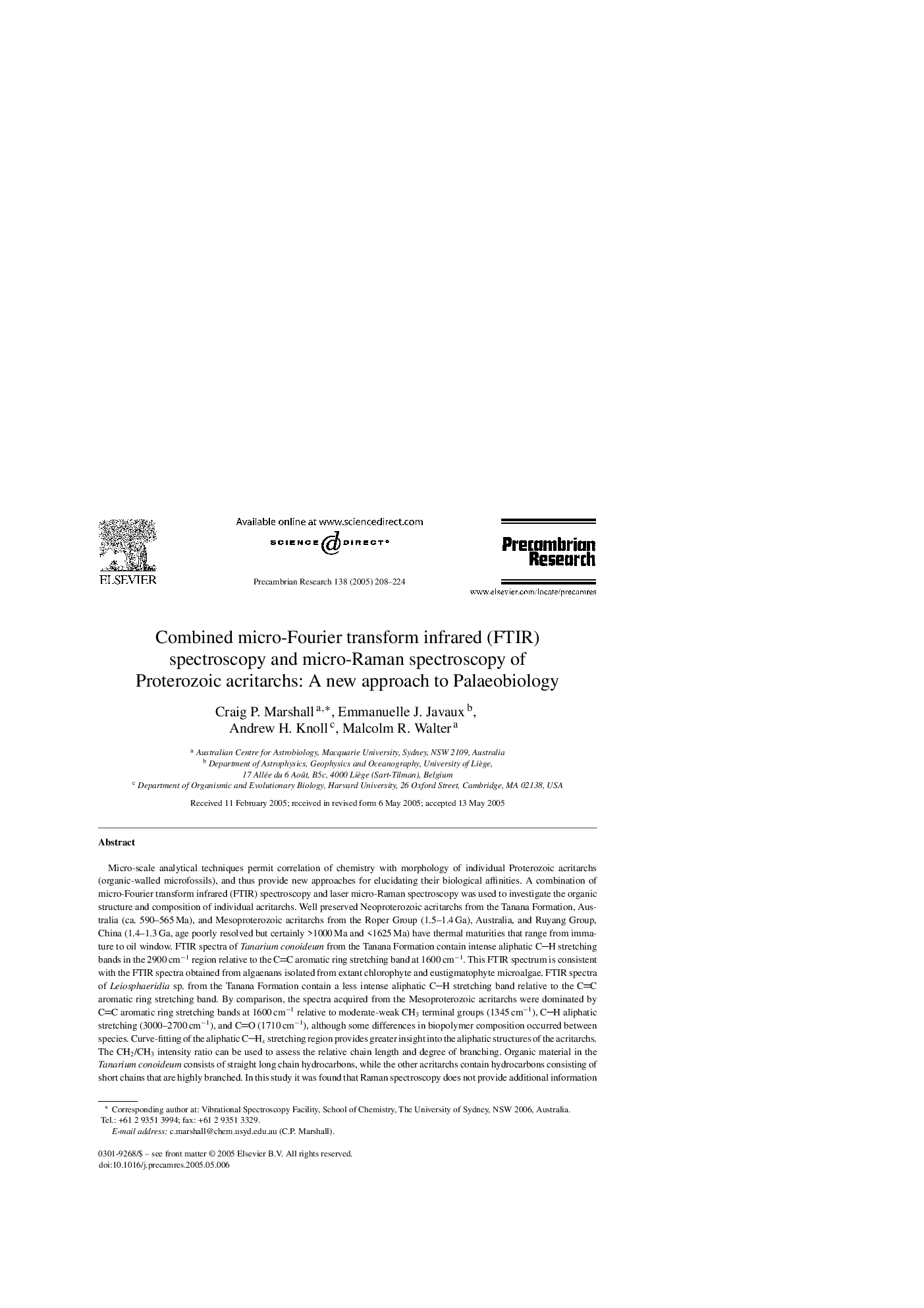| کد مقاله | کد نشریه | سال انتشار | مقاله انگلیسی | نسخه تمام متن |
|---|---|---|---|---|
| 9533806 | 1639751 | 2005 | 17 صفحه PDF | دانلود رایگان |
عنوان انگلیسی مقاله ISI
Combined micro-Fourier transform infrared (FTIR) spectroscopy and micro-Raman spectroscopy of Proterozoic acritarchs: A new approach to Palaeobiology
دانلود مقاله + سفارش ترجمه
دانلود مقاله ISI انگلیسی
رایگان برای ایرانیان
کلمات کلیدی
موضوعات مرتبط
مهندسی و علوم پایه
علوم زمین و سیارات
ژئوشیمی و پترولوژی
پیش نمایش صفحه اول مقاله

چکیده انگلیسی
Micro-scale analytical techniques permit correlation of chemistry with morphology of individual Proterozoic acritarchs (organic-walled microfossils), and thus provide new approaches for elucidating their biological affinities. A combination of micro-Fourier transform infrared (FTIR) spectroscopy and laser micro-Raman spectroscopy was used to investigate the organic structure and composition of individual acritarchs. Well preserved Neoproterozoic acritarchs from the Tanana Formation, Australia (ca. 590-565Â Ma), and Mesoproterozoic acritarchs from the Roper Group (1.5-1.4Â Ga), Australia, and Ruyang Group, China (1.4-1.3Â Ga, age poorly resolved but certainly >1000Â Ma and <1625Â Ma) have thermal maturities that range from immature to oil window. FTIR spectra of Tanarium conoideum from the Tanana Formation contain intense aliphatic CH stretching bands in the 2900Â cmâ1 region relative to the CC aromatic ring stretching band at 1600Â cmâ1. This FTIR spectrum is consistent with the FTIR spectra obtained from algaenans isolated from extant chlorophyte and eustigmatophyte microalgae. FTIR spectra of Leiosphaeridia sp. from the Tanana Formation contain a less intense aliphatic CH stretching band relative to the CC aromatic ring stretching band. By comparison, the spectra acquired from the Mesoproterozoic acritarchs were dominated by CC aromatic ring stretching bands at 1600Â cmâ1 relative to moderate-weak CH3 terminal groups (1345Â cmâ1), CH aliphatic stretching (3000-2700Â cmâ1), and CO (1710Â cmâ1), although some differences in biopolymer composition occurred between species. Curve-fitting of the aliphatic CHx stretching region provides greater insight into the aliphatic structures of the acritarchs. The CH2/CH3 intensity ratio can be used to assess the relative chain length and degree of branching. Organic material in the Tanarium conoideum consists of straight long chain hydrocarbons, while the other acritarchs contain hydrocarbons consisting of short chains that are highly branched. In this study it was found that Raman spectroscopy does not provide additional information about biopolymer composition of Proterozoic acritarchs, but rather offers complementary data regarding the aromaticity and degree of saturation of the macromolecular structure of acritarch cysts.
ناشر
Database: Elsevier - ScienceDirect (ساینس دایرکت)
Journal: Precambrian Research - Volume 138, Issues 3â4, 9 August 2005, Pages 208-224
Journal: Precambrian Research - Volume 138, Issues 3â4, 9 August 2005, Pages 208-224
نویسندگان
Craig P. Marshall, Emmanuelle J. Javaux, Andrew H. Knoll, Malcolm R. Walter,